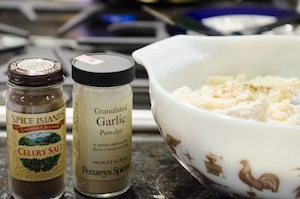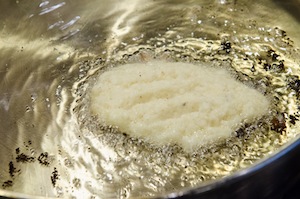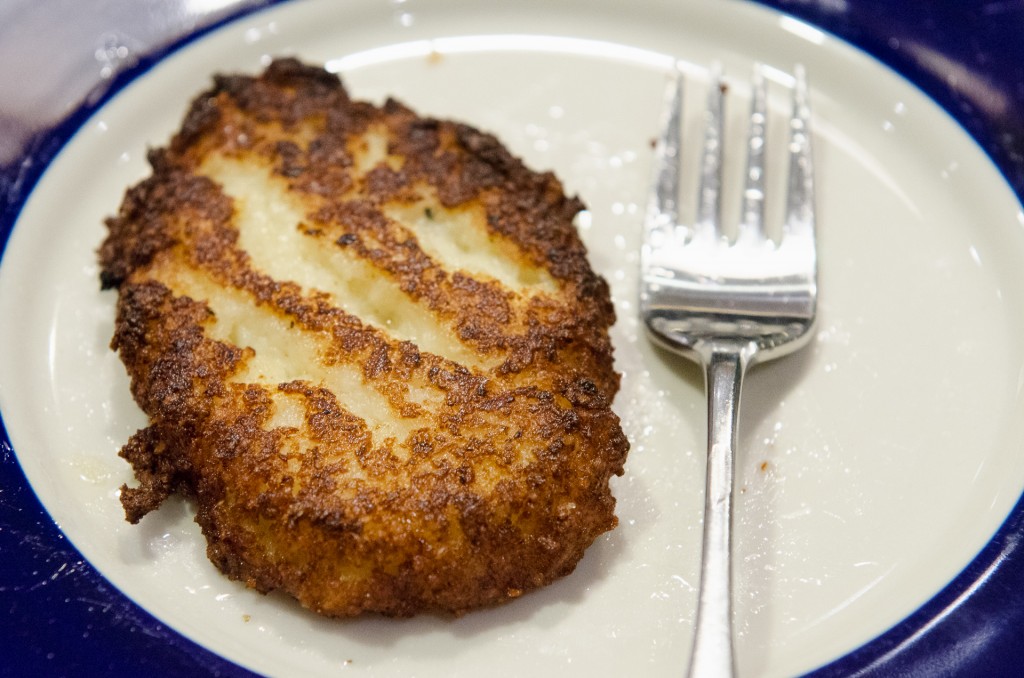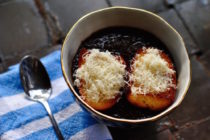This past weekend Eater Houston editor Eric Sandler invited a handful of foodie friends to learn a recipe that has been in his family for years — latkes. His sister Debbie Haseltine led the cooking lesson, and mom Susan Selvern Sandler welcomed us all into her home and kitchen. The recipe has been in the Sandler family for years and was always prepared by Eric’s father Carl Sandler, who passed away a few months ago. In a way of speaking, this was a celebration of Carl as well as a cooking demo.
Latkes are traditionally eaten by Jews during Hanukkah (in December), but they are satisfying dish that might be prepared anytime, especially during a chilly January. I’ve often heard latkes referred to as potato pancakes, but I don’t think that is quite accurate. They are really more like well-seasoned — these have lots of onions! — hashbrown patties, and they’re really easy to make. If you’ve got large Russet potatoes and yellow onions, you’re ready to go.
Sandler Family Latkes (makes approximately 20 latkes)
- 3 large Russet potatoes
- 2 large yellow onions
- 1 egg
- salt to taste
- pepper to taste
- 1 Tbsp. garlic powder
- 2 Tbsp. celery salt
- matzah meal (or panko, fine breadcrumbs or even flour)
- bottle of vegetable oil
 METHOD: Place the the peeled potatoes and onions (be sure to cut them into large chunks) in a large food processor and puree. You’ll probably need to divide this job into two or three batches because of the volume. After the potatoes and onions are finely pureed and look like mashed potatoes, strain them in a fine-mesh colander to remove the excess liquid. Do not skip this step. Excess liquid will prevent the latkes from frying properly, so try and get as much liquid out as possible. Next, dump the drained potato and onion mixture into a bowl. Add about 1/3 cup of matzah meal (or panko, etc.) to the mixture to thicken until you get the mixture the consistency of chunky oatmeal. Then add the egg, salt, pepper garlic powder and celery salt. Don’t be shy with your salt and pepper; the potatoes can handle a kick of seasoning. Mix well.
METHOD: Place the the peeled potatoes and onions (be sure to cut them into large chunks) in a large food processor and puree. You’ll probably need to divide this job into two or three batches because of the volume. After the potatoes and onions are finely pureed and look like mashed potatoes, strain them in a fine-mesh colander to remove the excess liquid. Do not skip this step. Excess liquid will prevent the latkes from frying properly, so try and get as much liquid out as possible. Next, dump the drained potato and onion mixture into a bowl. Add about 1/3 cup of matzah meal (or panko, etc.) to the mixture to thicken until you get the mixture the consistency of chunky oatmeal. Then add the egg, salt, pepper garlic powder and celery salt. Don’t be shy with your salt and pepper; the potatoes can handle a kick of seasoning. Mix well.
On medium-high heat, pour enough vegetable oil — about one cup, more if needed — into a large pan so that there is  about half an inch of oil in the pan. You want enough to fry the latke on the sides as well as bottom. Once your oil is hot, spoon one cooking-spoon amount of latke mix into the oil, carefully. This is your tester latke, so you’ll only make one to practice, allow it to cool and give it a taste test to see if you need to add seasoning to your mix. Your latkes shouldn’t be very thick, or else they won’t cook through. They should be about the size of your palm or smaller. If the oil is properly hot, you’ll notice the sides of your latke turning brown within one to two minutes. Gently flip it over. If it feels difficult to flip, it isn’t quite ready for flipping yet. Cook the other side of the latke and then place it on a plate covered in paper towels. They should be brown and lightly crunchy on the surface. The Sandler family uses something similar to a cookie cooling rack with paper towels underneath to catch excess oil. The latkes in turn cooled quickly and didn’t break or stick together.
about half an inch of oil in the pan. You want enough to fry the latke on the sides as well as bottom. Once your oil is hot, spoon one cooking-spoon amount of latke mix into the oil, carefully. This is your tester latke, so you’ll only make one to practice, allow it to cool and give it a taste test to see if you need to add seasoning to your mix. Your latkes shouldn’t be very thick, or else they won’t cook through. They should be about the size of your palm or smaller. If the oil is properly hot, you’ll notice the sides of your latke turning brown within one to two minutes. Gently flip it over. If it feels difficult to flip, it isn’t quite ready for flipping yet. Cook the other side of the latke and then place it on a plate covered in paper towels. They should be brown and lightly crunchy on the surface. The Sandler family uses something similar to a cookie cooling rack with paper towels underneath to catch excess oil. The latkes in turn cooled quickly and didn’t break or stick together.
Once you’ve practiced your frying, flipping and executed the taste test, you can probably fry three latkes at a time when using a large pan. Don’t crowd them. Make the entire batch of latkes. What you don’t eat, stick in the freezer — they freeze nicely, and reheat well in a 200 degree oven for five to 10 minutes.
Eat with a dollop of sour cream or apple sauce. Or both — I like to split a latke in half and use both as condiments.
So what to pair with these little potato patties? I came up with some ideas that would be especially great with this mixed chilly and wet January weather: Serve them with venison chili, a roast chicken, pot roast or brisket, or a cup of split-pea soup. I ate seven in one serving and left the cooking class feeling quite full — no entree necessary for me.







Follow Us